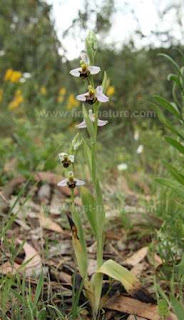 An Alpine Meadow in Slovenia
An Alpine Meadow in Slovenia

 Bird's-nest Orchid growing with Butterfly Orchids
Bird's-nest Orchid growing with Butterfly Orchids
Regrettably we were too early to see Gymnadenia rhellicani (Black Vanilla Orchid) and Gymnadenia rubra (Red vanilla Orchid). These orchids were previously called Nigritella nigra ssp. rhellicani and Nigritella rubra respectively. We also failed to find Lady’s-slipper Orchid (Cypripedium calceolus) despite being there at the right time for it to be flowering. Species we did find, and in great abundance, were Common Spotted-orchid (Dactylorhiza fuchsii), Bird’s-nest Orchid (Neottia nidus-avis), Sword-leaved Helleborine (Cephalanthera longifolia), White Helleborine (Cephalanthera damasonium), Red Helleborine (Cephalanthera rubra), Dark-red Helleborine (Epipactis atrorubens), Lesser Butterfly Orchid (Platanthera bifolia), Common Twayblade (Neottia ovata). In smaller numbers we found Coral-root Orchid (Corallorrhiza trifida) and Burnt Orchid (Orchis ustulata). Both Chalk Fragrant-orchid (Gymnadenia conopsea) and Gymnadenia odoratissima grow together in the dry Alpine meadows. This list just scratches the surface of the vast number of orchid species it’s possible to see in Slovenia and we are really hoping that we’ll be able to return again soon to see many more.

The one and only - a single Military Orchid on a roadside in Slovenia

 We saw more Bee Orchids than usual in the Algarve this spring.
We saw more Bee Orchids than usual in the Algarve this spring. Anacamptis champagneuxii photographed near Monchique
Anacamptis champagneuxii photographed near Monchique